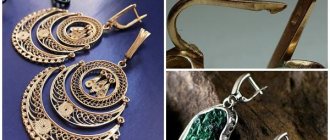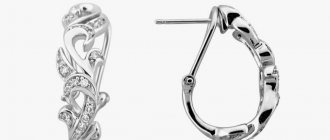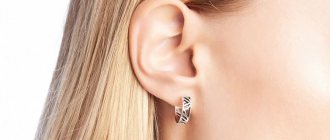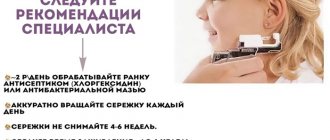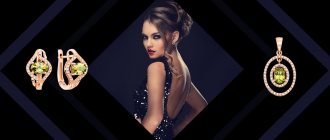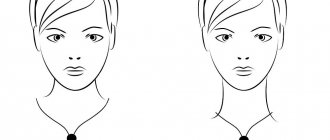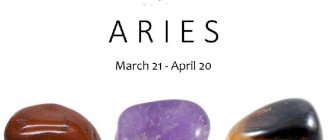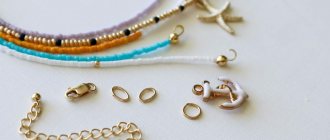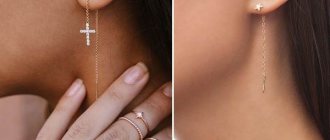Share on social media networks:
Earrings with an English lock are a durable and beautiful invention of professional jewelers. This fastening method occupies a leading position among all popular fasteners. But, unfortunately, many representatives of the fair sex are faced with a certain problem and do not know how to unfasten an earring ring on their ears, or how to remove and open earrings with an English lock. There are times when a girl goes to a specialist to have her or her child unfasten such a tight lock in order to remove the jewelry. Let's figure out how to easily and quickly remove such earrings.
How to remove earrings with an English lock?
Earrings with an English lock are a durable and beautiful invention of professional jewelers. This fastening method occupies a leading position among all popular fasteners. But, unfortunately, many representatives of the fair sex face a certain problem and do not know how to remove earrings with an English lock. There are times when a girl goes to a specialist to have her or her child unfasten such a tight lock in order to remove the jewelry. Let's figure out how to easily and quickly remove such earrings.
Modern way of ear piercing
For the procedure, special medical earrings made of hypoallergenic alloy are used. They have a pointed end, which makes the procedure easy and virtually painless. The earring is placed in a special device, often called a “gun”. Then, with its help, piercing is carried out, followed by fixing the earring with a lock on the opposite side of the earlobe.
When and how to remove stud earrings? Before removal, some time must pass after the puncture so that the canal can heal completely. This usually takes up to one and a half months.
English latch - device features
What is an English latch on earrings? The English castle is also called a lock lock. Previously, it was used for heavier and more massive jewelry, but now it is widely used for making smaller jewelry (children's earrings).
The English latch consists of a hook and a small pin. The earring is a narrow metal strip that covers the earlobe from the bottom, and the pin is inserted in the center of the earlobe, where the pierced hole is located. The pin has a base slightly narrower than the width of the hook, so when it gets into its hole, the hook closes the lock with a barely audible click. It is due to this design that earrings with an English clasp are considered the most reliable and convenient to use jewelry.
Inserts
Inserts are another form of decorating jewelry. Their choice is determined by the style of the earrings, fashion trends and tendencies. For example, this season, products with animal prints, neon inserts and cowboy motifs are at the peak of popularity.
Cast is the part of the earring that is responsible for fixing the insert. There are no specific classifications here. The only sign by which these fragments can differ is size. It is determined by the insertion scale.
Advantages:
- Reliability.
- Convenience.
- Attractive appearance.
- It is extremely rare for the clasp to become bent.
- The ability to close a wide puncture with its elongated design.
- It is impossible to prick yourself with the fastener in a dream.
- Jewelry with such a lock is very difficult to lose.
Flaws:
- There is no possibility of adjusting the clasp.
- Not suitable for a wide lobe (compresses it tightly).
- Designed for people who wear earrings without removing them.
- Many people cannot figure out the technique of using such a fastener.
- If handled incorrectly, the lock can become loose, which will require repairs in a workshop.
- By adjusting the pin yourself, you can cause the product to bend.
Important! If during the use of jewelry your lock has become loose, this does not mean poor quality of the product or a manufacturing defect. This was most likely due to your ignorance of the correct use of the English clasp.
Silicone plugs for hooks
Good day everyone.
I ask for advice from jewelers and craftsmen who work with costume jewelry. Such a problem. I have silicone plugs on my gold stud earrings (I lost my gold ones). Today I wanted to take off my earrings, but the plugs wouldn’t budge (. I took them off two months ago, with difficulty, really. And now I don’t know how to remove them. Is there any softener for these plugs? Have you ever encountered such a problem? I’ll be glad to hear your advice because by the second day I’m walking around with swollen lobes))) PS I’m in a hurry to share) I took off the plugs. The earlobes, from my attempts to remove the plugs by force, became so swollen that I had to take urgent measures. I was going to see a surgeon, but I decided to take the last chance because my husband is now on a business trip and there was no one to help me (my sons were afraid)))) I did this: I heated the plug with a hairdryer, that’s how much patience I had and nail clippers I slowly began to bite off pieces of silicone. She bit off half of it, and the second half came off on its own, this is on one earring, and on the other completely in pieces - she bit off and took off, she bit off and took off. The conclusion is that the silicone warms up from the heat and, in principle, the plugs can be removed, but it is still better not to use them for everyday wear and not expose yourself to unpleasant consequences. Thanks everyone and good luck!
maybe if there is someone next to you, try to carefully cut them (cut them off) with scissors, a knife, wire cutters, a blade, or a nail file. Maybe they’ll come off like that (come off)?
. most likely this happened due to frequent contact with water (in the bathroom) chlorinated water dries ((
ps:: I'm already worried about you! I'm sitting wondering how you can take them off. I thought maybe I could drop some vegetable oil on them and rub them lightly so that the oil gets between the plug and the gold. I don't know, but it's worth a try! It definitely won't get any worse
I tried it with oil, but it doesn’t come off!
Try applying Vaseline oil.
Thanks, I'll try, but the oil slips and it's very difficult to grab both the earring and the plug.
Good night! Try twisting them clockwise and counterclockwise, holding the earring with one hand and twisting with the other...
)))) She twisted it so hard that her earlobes became swollen. I actually think that I’ll have to bite the stem of the clove ((((
Well, of course, you can bite the stem of the carnation, but this is a last resort... it would be a shame to ruin the gold earrings. ((
Try to “bite” the plug itself first
Yes, I’ll probably try to bite the plug) And what’s strange. They didn’t seem to be very hard, but now they’re just like glass!
like glass - it’s all from chlorinated water (we washed in them, after all) and temperature changes, of course
Well, I don’t know.. But it just seems to me that silicone plugs have the same properties as most silicone rubber, namely, some properties change at different temperatures. Take it like a hot bath. Theoretically, when exposed to hot water or steam, the silicone should soften. Take it off there.
It's really worth trying a bath as Oksana advises. What if it helps! I think this is a good idea!
Thank you) I work with dolls and “communicate” a little with silicone) and I thought the same thing, that maybe the water will soften it, but it doesn’t! The bath didn’t help (I’ll try to wet cotton pads and hold them on my earlobes, because the silicone seems to soften from the heat.
Not if you just hold the cotton pads on your earlobes - this obviously will not heat the silicone. Lie in the hot tub until your earlobes are under water. And try to remove it right there, otherwise, while you get out of the bathroom, the silicone will “shrink” again, having cooled down.
I have long noticed that silicone plugs behave differently at different temperatures. I was convinced of this when I lost one carnation with a beautiful stone (it was wildly hot). The pebble on the nail was quite large. In the heat, silicone becomes soft and pliable, more friable or something - that’s how the stone outweighed it. In the cold, on the contrary, silicone becomes harder.
Yes, yes, now they are like glass!
Yes, everything is sad. I looked it up on the Internet, but you found yourself in a situation! Read this - this is the truth about sealant, but also silicone https://www.otdellka.org.ru/index.php/germetik. In general, the “pipe” is a matter. What they are offering, of course, will not suit you - if you damage your earlobe, you will at least get a chemical burn. Of these products, however, there is one that is more or less harmless (compared to others) - kerosene - it softens the silicone (maybe it will soften it in an hour). But first, try the bathroom. If it doesn’t help, then kerosene (not gasoline, you’ll burn your skin).
Recommendations
An English clasp for jewelry is made from the same metal as the earring itself - most often it is gold or silver. Since these metals are very soft and ductile, when using earrings you need to follow a few simple tips:
- You need to open the lock without much effort, and close it just as weakly - waiting for the first click. If the hook has passed beyond the recess in the pin, this means that the lock is broken and requires immediate repair. If you try to repair it yourself, you may bend or even break off the tip or half of the safety clasp. Do not experiment, but entrust the repair to a professional.
- Remove earrings with an English lock before going to bed, playing sports, while visiting the pool or sauna, while washing and especially coloring your hair, while actively playing with children and while removing a woolen sweater over your head. This way you will avoid not only breakage of the product, but also pricks in the neck from the clasp, as well as the loss of expensive gold jewelry.
- If you cannot cope with opening the English latch on your own, then call your household for help, who will clearly see the entire mechanism and the essence of the whole problem.
- If this is your first time encountering this type of clasp, then practice taking off and putting your earrings back on several times, so that later you can do it without outside help.
- If you can’t undo the English clasp, drop a little olive or sunflower oil on the pin. After such actions, the mechanism will become more plastic and pliable.
- To remove earrings with an English lock, you can use tweezers, which must be used extremely carefully so as not to scratch the expensive metal.
- The most important rule to remember before starting any manipulations with the piercing hole is to follow the rules of hygiene: wash your hands and disinfect your earlobe and jewelry with medical alcohol.
We really hope that now you can easily remove earrings with an English lock. And the recommendations described above will help you protect your favorite jewelry from various mechanical and chemical influences. Let your jewelry be not only beautiful, but also comfortable! Enjoy the shopping!
What to do if the earring “does not open”?
First, it’s worth figuring out why this happened. If the trouble is caused by an unhealed injury to the lobe after it was pierced, then the secretions accumulated under the lock are to blame. They need to be removed, and then the latch will start working normally. Elimination is carried out through hygienic treatment. In a caring and disinfectant solution, soak cotton wool and carefully wipe the ear and earring with it. Upon completion of extraction, the processing is repeated.
If the problem is caused by other factors, then you need to do the following:
- call someone for help (let another person try to deal with the lock, and if that doesn’t work, then ask him to consider the reason for the jamming of the latch);
- use tweezers (use them carefully, otherwise you will scratch the metal of the jewelry);
- apply a little oil to the latch;
- try opening the lock with a disc soaked in alcohol or oil.
The last option is primarily addressed to those who cannot unfasten an earring with an English clasp. The design of the fixing element involves lifting the pin upward. This is done with the pad of the thumb. If you place a cotton pad between it and the pin, the area of influence on the lock will increase, while reducing the load on the skin and finger.
Important! Manipulations with earrings - removing, putting on - should ideally be carried out only with clean hands. It is also worth taking care of your jewelry and cleaning it regularly. Compliance with these 2 rules will avoid irritation, reduce the likelihood of ear damage and infection from dirty earrings, and also prevent the lock from jamming due to dirt accumulated on its small elements.
If we are talking about an earring that was recently inserted in the salon during or after a piercing, then you need to act differently. Before removal, you should treat the earlobe and earrings, and then try to carefully remove the jewelry. If there is bleeding or you cannot remove the accessory, you should not apply oil or use tweezers. You just need to contact the specialist who performed the puncture. He will figure out the reason for the delayed healing and take adequate measures.
Advantages and disadvantages of an English castle
Jewelers constantly turn to the reliability of an English castle. Especially when they create earrings with a large number of precious and semi-precious stones. It is this mechanism that can withstand loads on the pin without deforming it.
The advantages of latches “from England” are as follows:
- reliability and practicality;
- simplicity and ease of closure;
- attractive appearance;
- strength - deformation of the latch rarely occurs;
- the ability to close a stretched hole in the earlobe;
- impossibility of losing jewelry if the mechanism is working properly.
- lack of size adjustment;
- poorly suited for a large lobe - it pinches it too much;
- it is difficult to remove earrings, especially for the first time after wearing new jewelry;
- You cannot adjust the length of the pin yourself - curvature will occur.
Important! If you have been wearing earrings for only 1-2 months, and the lock is already loose, this indicates a manufacturing defect. Or you damaged the mechanism due to improper handling of the clasp.
Removing earrings
In order to remove earrings from your ears, avoiding injury or infection, you must:
- Stand in front of the mirror;
- Wash your hands using soap or antibacterial product;
- With the thumb and forefinger of one hand you should take the earring by the head (front part), and with the other hand you need to grab the clasp from behind and gently but forcefully pull it to the side;
- If you cannot firmly grasp the lock, you can try to loosen it using nail scissors. The tips of the scissors need to be inserted into the semicircular loops on the back of the clasp and carefully pulled apart. As a result, removing the earring will be easy;
- Treat the earlobes with a gauze swab dipped in hydrogen peroxide. It is not advisable to use cotton wool - if the puncture has not healed completely, small fibers can get into it, causing pain;
- Walk around without earrings for a couple of hours;
- Insert jewelry into your ears (the same studs or new earrings), after treating them with peroxide. This should be done carefully, without pressing the clasp very tightly to the skin;
It is advisable not to remove the product at all for about six months. Later you can choose and change earrings without restrictions.
When deciding to decorate your ears with earrings, you should pay attention to some important details:
- It is preferable to carry out ear piercing in winter - at this time the risk of infection is minimal;
- The first time after piercing the earlobes, you need to treat the wounds daily with a 1% solution of salicylic acid or peroxide before going outside, after returning home, before and after sleep or shower;
- Starting from the second day after the procedure, you should rotate the earrings in your ears with clean hands;
- Until the wounds heal, it is not recommended to sleep on other people’s pillows, touch your earlobes with your hands again, or bathe;
- You should not take off your earrings for a long period. To avoid overgrowth of piercings, it is advisable to insert carnations into the ears for at least a few minutes a day.
This article is provided for informational purposes only and should not be used as a guide to action without prior consultation with a qualified specialist in the relevant field (doctor).
How to properly unfasten the latch
Fastening and unfastening an English lock is not as difficult as it seems at first glance. It is very easy to fasten: just get the pin into the hole. A slight click will be heard. He indicates that the mechanism has closed.
To properly unfasten the English lock, do the following:
- Hold the wire with two fingers.
- Using the thumb of your free hand, pry the pin, pushing it upward.
- The lock will open. You will feel that the earring has become loose in the lobe. This will cause the pin to rise up.
Important! Do not use too much force when opening. You can deform the lock. After all, gold and silver are ductile and soft metals.
Unfasten the loop earring
There are 2 types of loop earrings. One is not fixed in any way at the opposite end; it is held on the ear due to the long length of the earpiece and a slight rounding on it (may be absent). The second has the tip threaded into the hook.
The first option is easy to remove. You need to pull the lobe down a little and remove the jewelry from it. In this case, sudden movements should be avoided, since the elongated wire can damage the ear from a jerk.
A loop earring with a hook is removed differently:
- the thumb is placed on the back of the loop, and the index finger on the front;
- the earring is slightly compressed (because of this, the gap between the walls of the loop is reduced);
- use the fingertip of the second hand to lower the hook down;
- remove the jewelry from the earlobe in the same way as in the case of a regular loop earring.
Important! When you squeeze the jewelry, do not apply much force, otherwise the accessory will deform very quickly.
Advantages and disadvantages of an English castle
Jewelers constantly turn to the reliability of an English castle. Especially when they create earrings with a large number of precious and semi-precious stones. It is this mechanism that can withstand loads on the pin without deforming it.
The advantages of latches “from England” are as follows:
- reliability and practicality;
- simplicity and ease of closure;
- attractive appearance;
- strength - deformation of the latch rarely occurs;
- the ability to close a stretched hole in the earlobe;
- impossibility of losing jewelry if the mechanism is working properly.
- lack of size adjustment;
- poorly suited for a large lobe - it pinches it too much;
- it is difficult to remove earrings, especially for the first time after wearing new jewelry;
- You cannot adjust the length of the pin yourself - curvature will occur.
Important! If you have been wearing earrings for only 1-2 months, and the lock is already loose, this indicates a manufacturing defect. Or you damaged the mechanism due to improper handling of the clasp.
Suspension
A pendant is a randomly descending decorative element of decoration. It is not mandatory in the structure of the earring; it appears when the design idea requires it.
The pendant does not have to be metal. So, for example, in the autumn-winter season 2018/19 the following options remain relevant:
- fringed tassel pendants that reference cowboy motifs;
- flowing clear pendants with rhinestones;
- pendants with plastic neon inserts are the main trend on the Parisian catwalks.
Models with pendants are the easiest way to diversify your look, visually lengthen your neck, and make your facial features more harmonious and aesthetic.
How to properly unfasten the latch
Fastening and unfastening an English lock is not as difficult as it seems at first glance. It is very easy to fasten: just get the pin into the hole. A slight click will be heard. He indicates that the mechanism has closed.
To properly unfasten the English lock, do the following:
- Hold the wire with two fingers.
- Using the thumb of your free hand, pry the pin, pushing it upward.
- The lock will open. You will feel that the earring has become loose in the lobe. This will cause the pin to rise up.
Important! Do not use too much force when opening. You can deform the lock. After all, gold and silver are ductile and soft metals.
